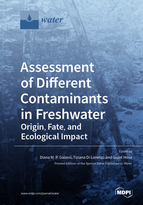Assessment of Different Contaminants in Freshwater: Origin, Fate, and Ecological Impact
A special issue of Water (ISSN 2073-4441). This special issue belongs to the section "Water Quality and Contamination".
Deadline for manuscript submissions: closed (30 April 2020) | Viewed by 40805
Special Issue Editors
Interests: groundwater, ecology, pollution, GDEs (groundwater-dependent ecosystems), biodiversity assessment, meiofauna, stygobites
Interests: ecological risk assessment; functional ecology; groundwater ecology; compounds of emerging concern
Special Issues, Collections and Topics in MDPI journals
Special Issue Information
Dear Colleagues,
Freshwaters in many parts of the world are subject to frequent and intense large-scale disturbances. Pollution, irrigation withdrawal, alteration of freshwater flows, road construction, aquifer mining, surface water diversion, desertification, wetland drainage, soil erosion in agriculture, deforestation, and dam building have led to some irreversible species losses and severe changes in community compositions of freshwater ecosystems. Pollution represents one of the most relevant impacts on freshwater environments, ranging from surface water bodies—such as springs, streams, rivers, lakes, and intermittent waterbodies—to groundwater and transitional habitats between surfacewaters and groundwaters. The origins and fates of pollutants are different, and depend on the pollutants considered: including fertilizers, together with pesticides, in agricultural areas; heavy methals, chlorinated organic compounds, and polycyclic aromatic hydrocarbons (PAHs) predominantly deriving from industrial and urban settlements; as well as microplastics, which are increasing in concentration in freshwater bodies, and which, together with pharmaceuticals, personal care products (PCPs), and endocrine-disrupting compounds (EDCs), constitute the emerging contaminants in freshwater systems. The broad distribution of several pollutants is leading to significant changes of freshwater ecosystems, together with the extinction of the most sensitive species or the drastic lowering in abundances of others, thus altering community compositions and the ecosystem services provided by freshwater biodiversity.
Prof. Diana M. P. Galassi
Dr. Tiziana Di Lorenzo
Prof. Grant Hose
Guest Editors
Manuscript Submission Information
Manuscripts should be submitted online at www.mdpi.com by registering and logging in to this website. Once you are registered, click here to go to the submission form. Manuscripts can be submitted until the deadline. All submissions that pass pre-check are peer-reviewed. Accepted papers will be published continuously in the journal (as soon as accepted) and will be listed together on the special issue website. Research articles, review articles as well as short communications are invited. For planned papers, a title and short abstract (about 100 words) can be sent to the Editorial Office for announcement on this website.
Submitted manuscripts should not have been published previously, nor be under consideration for publication elsewhere (except conference proceedings papers). All manuscripts are thoroughly refereed through a single-blind peer-review process. A guide for authors and other relevant information for submission of manuscripts is available on the Instructions for Authors page. Water is an international peer-reviewed open access semimonthly journal published by MDPI.
Please visit the Instructions for Authors page before submitting a manuscript. The Article Processing Charge (APC) for publication in this open access journal is 2600 CHF (Swiss Francs). Submitted papers should be well formatted and use good English. Authors may use MDPI's English editing service prior to publication or during author revisions.
Keywords
- freshwater
- pollution
- emerging contaminants
- microplastics
- ecotoxicology
- ecological impact
- freshwater communities
- biodiversity








